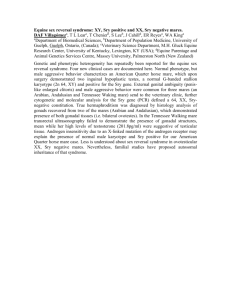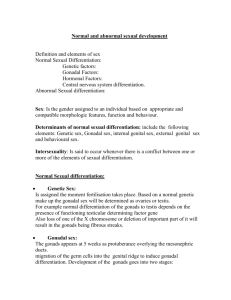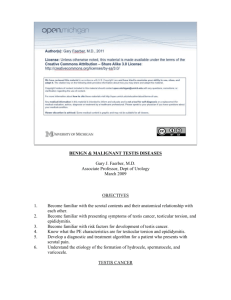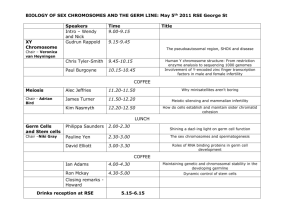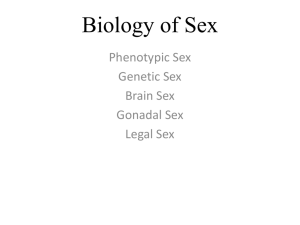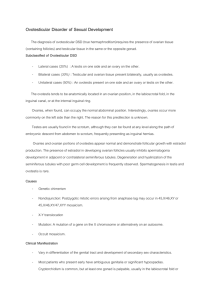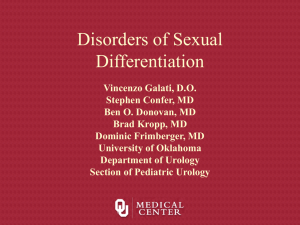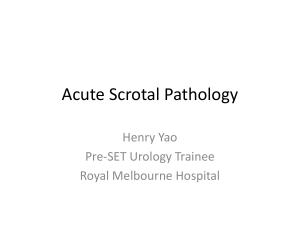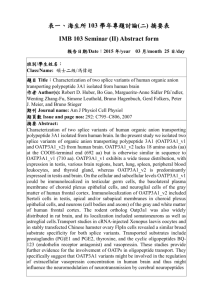Hermaphroditism pathology - RJME
advertisement
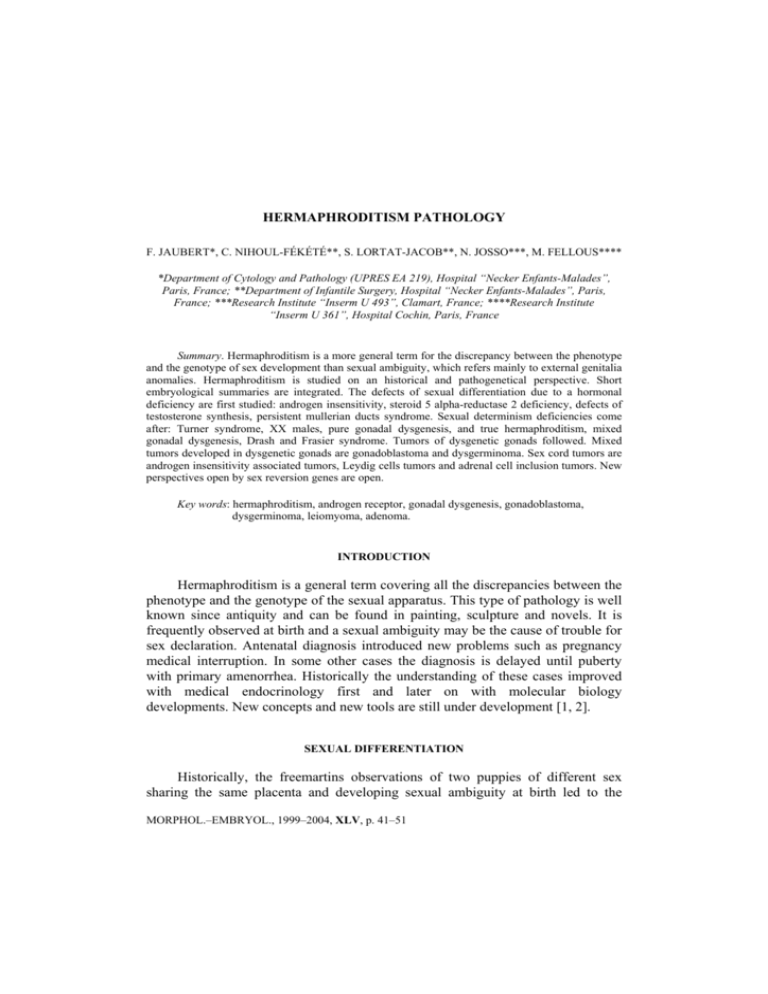
HERMAPHRODITISM PATHOLOGY F. JAUBERT*, C. NIHOUL-FÉKÉTÉ**, S. LORTAT-JACOB**, N. JOSSO***, M. FELLOUS**** *Department of Cytology and Pathology (UPRES EA 219), Hospital “Necker Enfants-Malades”, Paris, France; **Department of Infantile Surgery, Hospital “Necker Enfants-Malades”, Paris, France; ***Research Institute “Inserm U 493”, Clamart, France; ****Research Institute “Inserm U 361”, Hospital Cochin, Paris, France Summary. Hermaphroditism is a more general term for the discrepancy between the phenotype and the genotype of sex development than sexual ambiguity, which refers mainly to external genitalia anomalies. Hermaphroditism is studied on an historical and pathogenetical perspective. Short embryological summaries are integrated. The defects of sexual differentiation due to a hormonal deficiency are first studied: androgen insensitivity, steroid 5 alpha-reductase 2 deficiency, defects of testosterone synthesis, persistent mullerian ducts syndrome. Sexual determinism deficiencies come after: Turner syndrome, XX males, pure gonadal dysgenesis, and true hermaphroditism, mixed gonadal dysgenesis, Drash and Frasier syndrome. Tumors of dysgenetic gonads followed. Mixed tumors developed in dysgenetic gonads are gonadoblastoma and dysgerminoma. Sex cord tumors are androgen insensitivity associated tumors, Leydig cells tumors and adrenal cell inclusion tumors. New perspectives open by sex reversion genes are open. Key words: hermaphroditism, androgen receptor, gonadal dysgenesis, gonadoblastoma, dysgerminoma, leiomyoma, adenoma. INTRODUCTION Hermaphroditism is a general term covering all the discrepancies between the phenotype and the genotype of the sexual apparatus. This type of pathology is well known since antiquity and can be found in painting, sculpture and novels. It is frequently observed at birth and a sexual ambiguity may be the cause of trouble for sex declaration. Antenatal diagnosis introduced new problems such as pregnancy medical interruption. In some other cases the diagnosis is delayed until puberty with primary amenorrhea. Historically the understanding of these cases improved with medical endocrinology first and later on with molecular biology developments. New concepts and new tools are still under development [1, 2]. SEXUAL DIFFERENTIATION Historically, the freemartins observations of two puppies of different sex sharing the same placenta and developing sexual ambiguity at birth led to the MORPHOL.–EMBRYOL., 1999–2004, XLV, p. 41–51 42 F. Jaubert et al. discovery of sex hormones. Testosterone and dehydrotestosterone were first isolated. Later on the antimullerian hormone was discovered. It is well known that at an early stage of embryology before the gonad differentiation, wolfian and müllerian structures are present. The testis induces male differentiation by testosterone stimulation of the Wolfian duct and AMH cause Mullerian duct regression. The reverse happened in case of ovary differentiation of the gonad (Figure 1). SEXUAL DIFFERENTIATION PATHOLOGY Complete androgen insensitivity syndrome was first isolated and understood (past feminizing testis) [4, 5, 6, 7]. Androgen receptor gene is located on chromosome X short arm (HUMARA) and gives a cytoplasmic protein first. The androgen fixation site has less affinity for testosterone than for dehydrotestosterone, which results from testosterone transformation due to steroid 5 alpha reductase 2 in the peripheral genital organs. After DHT fixation the androgen receptor migrates into the cell nuclei and gets attached to DNA through two zinc finger structures (Figure 2). There is also a site for androgen receptor dimerisation on the protein. In case of complete deficiency of the androgen receptor, the phenotype is female with no pilosity at puberty and a primary amenorrhea leading to the 46XY karyotype discovery as well as to the absence of uterus on X-rays or ultrasounds. There are two testes frequently in the abdominal wall in the middle in front of pubis. The testis has a leiomyoma outside of the albuginea, which is a good marker of the disease. Sometimes an early diagnosis is made after birth by the discovery of a testis in an inguinal hernia under repair (Figure 3). When testes are removed later on they are frequently sausage shaped with multiples nodules inside, corresponding to some variety of Sertoli adenoma with a spindle cell stroma between the tubules deprived of germ cells (Figure 4). The stroma becomes preponderant while aging. Prophylactic gonadectomy is recommended even if the cancer risk is low around 1% because the gonads are of no use. The earlier gonadoblastoma detected is around 7 years, and some clinicians recommend a gonadectomy only after puberty. Familial forms of the disease are well known and preponderant, however sporadic cases due to neomutations represent 10% of cases. Mutations involved more frequently the DNA binding site, but they can be found also in the steroid-binding site. Mutations are always present in cases of complete androgen receptor deficiency. The uterus absence is explained by AMH secretion by the Sertoli cells of the testis, which induces the müllerian duct regression. The female external genitalia are due to the complete defect of local Hermaphroditism pathology 43 androgen receptor. The role played by androgen cofactors is still under study. There are animal models of the disease. Male pseudohermaphroditism is always 46XY and has to be split into defects of androgen peripheral activity (partial androgen receptor deficiency, steroid 5 alpha reductase type 2 deficiency) and defects of testis synthesis of testosterone. The sexual ambiguity observed is more or less important and there is no good correlation with the related deficiency. There is a prater grading system of the genitalia abnormalities. In some difficult cases two different enzymes deficiency may coexist, each one inherited from one of the parents. The clinical aspect of androgen receptor partial deficiency and of steroid 5 alpha reductase 2 is very close [8]. Genitalia are ambiguous with a prominent clitoris and no scrotal folds fusion on the midline surrounding a central orifice. There is a vaginal pouch opened on the posterior urethra seen on urethrography. The vaginal upper part is missing as well as the uterus. Testis is present. For partial androgen receptor deficiency the testis anomalies are the same as for complete androgen receptor insufficiency. In case of steroid 5 alpha reductase type 2 deficiencies there are no nodular formations and tumors are exceptional. The pattern observed later in life is a Sertoli cell only one. In case of partial androgen receptor deficiency mutations are rarely found. However in some familial cases a same mutation can give either a complete or a partial defect in the same fraters. For steroid 5 alpha reductase type 2 mutations are present at different sites of the enzyme which are more or less specific from one country suggesting strongly a founder effect. For the last case there is a mammary development at puberty and a sexual behavior reversal. It is considered to be due to the steroid 5 alpha reductase type 1 liver activity apparition at this age. Treatment varies according to the surrounding and the cultural background. Testosterone synthesis deficiencies in the testis mitochondria are revealed by a sexual ambiguity in 46XY patients. The testis appears normal but Leydig cells are absent or with clarified cytoplasm. The immunohistochemical detection of the different P450 molecules associated to the enzymes of testosterone synthesis show that Leydig cells are present but look like fibroblasts. In consequence the so-called Leydig cell agenesis is most of the time due to an enzyme deficiency. The same pattern happened in case of combined enzyme deficiency or of LH receptor deficiency. Persistent müllerian duct syndrome is another endocrine deficiency where a 46 XY male has a bilateral intra-abdominal transposition of the testis and a persistent uterus with an upper vaginal pouch opened in the urethra. The discovery is surgical and the surgical problem is that the deferents are embedded in the uterus wall [10]. 44 F. Jaubert et al. SEXUAL DETERMINISM The regular somatic karyotype obtained from blood lymphocytes shows regularly that females are 46XX and males 46XY. For a while peoples advanced that sex determination was based on blood group substances expression on the cells of the HY type. This hypothesis was completely dropped out after molecular biology development. It appears that there is a TDF region (testis determining factor) on the short arm of chromosome Y. SRY is the gene found in the TDF region, which is responsible of male determinism. SRY is a small gene with one exon and HMG box allowing its fixation to DNA. Its transgenic insertion in XX mice induces 30% of male development. The SRY protein can be detected immunohistochemicaly in the testis during development and in maldevelopped gonads [11, 12, 13, 14]. The SRY gene is in fact part of a cascade of events involving upstream genes like WT1 and SF1 and downstream genes like AMH. SEXUAL DETERMINISM PATHOLOGY Turner syndrome, XX males, pure gonadal dysgenesis, true hermaphroditism, mixed gonadal dysgenesis Drash and Frasier syndrome are illustrations of abnormal sex determinism. Turner syndrome, even it is not a hermaphroditism, has to be studied for a better understanding. It is linked to 45XO karyotype, giving a short stature, a web neck and primary amenorrhea. Antenatal diagnosis is evocated by a median neck hygroma. Pregnancy interruptions showed that the ovaries contained initially an insufficient number of primary follicles and that they were disappearing around birth. This primary follicle senescence is the cause of the amenorrhea. Gonads remain as fibrous streak all the life long in these people. But Turner-like syndromes with a XX, XO karyotype turned out to have a Y fragment as shown by FISH (Fluorescent In Situ Hybridizations). Such cases have a risk of 15% of developing a malignant germinal tumor such as a gonadoblastoma or a dysgerminoma. That is the reason why a clinical survey and gonad removal is recommended [15]. XX males have a short stature also and two testes in normal position. In a minority of cases the SRY gene is present and translocated to X chromosome short arm or less frequently to an autosome. When SRY is on the X chromosome there is a family transmission with a normal father having the abnormal chromosome. The children are either XX males or true hermaphrodites [16, 17, 18]. Pure gonadal dysgenesis has a complete female phenotype, with uterus and vagina [16, 19]. Diagnosis is most of the time done at puberty because of primary amenorrhea. Streak gonads are found bilaterally and the karyotype is 46 XY. Streak gonads are remnants of maldevelopped gonads whatever their origin. In Hermaphroditism pathology 45 many cases some primary tubules can be found as well as a rete testis. When all these elements are missing there is generally a SRY mutation (Figure 5). However, SRY mutations explain only 10% of cases. The underlying mechanism remains unknown for the others. Dysgenetic gonads with Y chromosome are at risk of developing a germ cell tumor in 30% of cases: gonadoblastoma, dysgerminoma and have to be removed. True hermaphroditism is frequently revealed by a sexual ambiguity or a clitoromegaly. Its definition is the presence in the same person of two types of gonad differentiation: ovary and testis. Karyotype varies from 46XX to 46XX, XY but the existence of 46XY cases is controversial because the differential is mixed gonadal dysgenesis [20]. Most frequently the gonad is an ovotestis. Ovary develops at one pole and sends an extension around the testis part. The testis albuginea is abnormal and may contain some primary follicles and the tubules are irregularly arranged (Figure 6). Germ cells are present in the tubules but there is no connection with the epidydimus. The ovary is rich in primary follicles. Frozen sections are of help for guiding the surgeon in a partial gonadectomy adapted to the elevate sex chosen in order to have a function. When an ovary is present there is always a homolateral hemiuterus. Female sex choice is resulting in normal puberty and fertility. By contrast the male sex choice is giving a spontaneous puberty but infertility and in a few cases mensual swelling of the scrotum due to the maturation of residual follicles. Altering hermaphroditism with an ovary on one side and a testis on the other are uncommon, less than 10%. The SRY gene can be found by molecular biology in only 10% of 46 XX true hermaphroditism [13, 21]. However, in very rare cases the mosaicism is not constitutional but limited to the gonad. The tubule differentiation is not depending on the presence of XY cells and even in mosaicism part of the Sertoli cells are XX. This fact is demonstrated in mice as well as in humans. The underlying mechanism remains unknown. Tumor frequency is estimated around 1% in such cases however there is no series published correlating the presence of Y material and tumors. There are some familial forms and animal models in mice and pigs. The genes involved are not identified at present. Mixed gonadal dysgenesis associates a testis and a streak gonad. Most of the cases are clear cut and altering [22, 23, 24, 25]. The karyotype is either 46XY or 46XY, XO. The Y chromosome loss is due to its instability due to DAZ gene deletion on the long arm. The testis on one side is dysgenetic with well-developed tubules in the middle and rarefaction of the tubules at the periphery. Some tubules may also be embedded in the albuginea (Figure 7). The streak gonad is controlateral with only fibrous tissue composed of interlacing spindle cells. It can be confused with an ovary stroma. In rare compound cases one pole of the testis has the streak pattern while the other has a streak pattern with sometimes some primary sex cord remnants. It has to be 46 F. Jaubert et al. differentiated from an ovotestis because there are no follicles inside. The sex of rearing is always male. Germ cell tumor risk is estimated to be around 30%. The genes involved in the disease are still unknown and DMRT1 gene is a good candidate. Drash syndrome associates a male pseudohermaphroditism to a proteinuria due to glomerulosclerosis and a nephroblastoma [26, 27]. A WT1 mutation is the cause of this rare syndrome and involves most of the time the third zinc finger digit of the protein allowing its DNA fixation. In fact complete Drash syndrome is a rare entity at the crossroad of three circles on a Venn diagram, which is conceptual but has no statistical value. Most of the time the diagnosis of Drash is made on two components only. Gonad anomalies observed during Wilms tumor surgery may be suggestive of the syndrome as well as a proteinuria due to glomerulosclerosis. Testis anomalies are covering a spectrum from normal to dysgenetic. Female cases were diagnosed by molecular biology and ovaries were considered first as normal until precocious menopause suggests that there is accelerated ovary senescence in such cases. The role of WT1 in follicle maintenance remains too precise. Frasier syndrome is another rare syndrome frequently revealed by a primary amenorrhea. The karyotype is 46 XY and there are two streak gonads [27, 28, 29]. Sometimes females followed for renal insufficiency due to glomerulosclerosis have amenorrhea at puberty leading to a 46XY karyotype discovery and the Frasier syndrome diagnosis. Associated tumors are gonadoblastoma, Wilms tumor and conjunctive tumors. WT1 exons are normal; however there is an intronic mutation involving the KTS site and leading to an alternative splicing source of a defective polymerization of WT1 protein. In consequence there is a spectrum of abnormalities linked to WT1 mutations leading to gonad anomalies, tumors and glomerulosclerosis. DYSGENETIC GONADS TUMORS Usually tumors of the gonads are subdivided into germ cells derived; mixed germ cells and sex cord elements derived and sex cord elements only derived. Only the two latter ones are found in dysgenetic gonads. MIXED GERM CELL AND SEX CORD CELLS TUMORS OF DYSGENETIC GONADS Dysgenetic gonads such as streak gonads from Turner-like syndrome 46XO, XY, mixed gonadal dysgenesis (association of streak and dysplastic testis), pure gonadal dysgenesis 46 XY (bilateral streak), 46XX, 46 XY hermaphroditism and androgen insensitivity syndrome are at risk of developing a sequence: gonadoblastoma, dysgerminoma. Hermaphroditism pathology 47 The risk is linked to chromosome Y material presence in a dysgenetic gonad. The gene responsible is thought to be TSPY [30], on the short arm of chromosome Y, which is nearby SRY but differs from it. The risk evaluation is 15% for Turnerlike syndromes XO, XX, it is 30% for pure gonadal dysgenesis XY but is not calculated for the other cases: true hermaphroditism, androgen insensitivity where gonadoblastoma may happened (1%). There is no such risk reported for steroid synthesis enzyme deficiencies. A gonadoblastoma is a premalignant germ cell tumor equivalent to ITGCN but developed in a dysgenetic gonad. It is composed of round nest of premalignant germ cells surrounded by Sertoli or Leydig cells. They are MIC-2 positive. The nest is surrounded by a continuous basement membrane. Some foci of basement membrane like material are present inside as small round proteinaceous concretions and calcifications are frequent. Only the presence of malignant germ cells inside allows the diagnosis of gonadoblastoma. The usual marker of malignant germ cells are PLAP and Ckit [32, 33], which are physiological expressed during development and can remain positive until 2 years post natal [34, 35]. When a few malignant germ cells are spilling over outside of the epithelial nests it is an early dysgerminoma (Figure 8). For such cases surgery only is sufficient, there is no other therapy indicated. However in some cases the tumors are ruptured during coeliosurgery and are considered as spilled over in the peritoneum and chemotherapy is given. Dysgerminoma in dysgenetic gonads is most of the time a voluminous tumor revealed by a complication. It is composed of a diffuse proliferation of germ cells like in a seminoma. Multinucleated giant cells may be present as well as a lymphoid and or an epithelioid stroma. The important point is to have a sufficient sampling of the tumor to be able to find a few remaining nests of gonadoblastoma inside the tumor (Figure 9). The treatment is that of a malignant tumor. There are no reports of other malignant components such as yolk sac tumor or choriocarcinoma like in adult testis. The link between the two previous situations gonadoblastoma and dysgerminoma is the common background, dysgenetic gonad and malignant germ cell and the evolution from one stage to the other is supported by the existence of intermediary forms like early dysgerminoma or the presence of gonadoblastoma remnants found in dysgerminoma. Dysgenetic testis developed an intratubular germ cell neoplasia variant, which can mimic gonadoblastoma when the continuity with the tubules is lost. The prognosis is good and surgery is sufficient. If the gonads are removed later the problem is that of a seminoma with associated ITGCN foci. Gonadoblastoma like structures can be found in testis and ovary of fetuses and of neonates. 48 F. Jaubert et al. – Most of the time, atretic structures composed only of Sertoli or follicular cells arranged in a nest with hyalines bodies inside are confused with gonadoblastoma but there are no germ cells [36, 37]. – Gonadoblastoma-like structures can be found in the testis of trisomy 18, but it is at the end of non-coiled maldevelopped tubules. – Gonadoblastoma-like structures is frequent in young girl’s ovary with germ cells inside and the immunohistochemical markers are of no value sometimes according to the age. Serial sections may find an ovogonia in the middle and there are no complications at follow-up with any treatment (Figure 10). SEX CORD TUMORS OF DYSGENETIC GONADS Androgen insensitivity syndrome (AIS) Paratesticular smooth muscle cells leiomyoma is a good marker of androgen insensivity syndrome. It is present at birth when a testis is found in an inguinal hernia in a young girl for example. Its origin is discussed and a mullerian duct remnant is favored. Sertoli cell adenoma or hamartoma (because the tubules are non coalescent and there is an interstitial spindle cell stroma which increases with age) developed in androgen insensitivity syndrome (Figure 4). They are not present at birth and appear after 7 years only and growth until puberty. The testis is sausage shaped with inside nodules. There is a disconnection from the epidydimus and a fallopian tube structures can be found in 10% of cases. The underlying mechanism is unknown, but it is sometimes linked to an AMH hypersecretion, which can be correlated with the enhanced AMH blood level. Leydig cell hyperplasia sometimes called adenoma is an ill limited focus of Leydig cells with some remaining tubules inside. It may be linked to AIS or be completely independent and associated to precocious puberty. Only a few cases of precocious puberty are due to an activating mutation of the LHR (receptor) of Leydig cells [38]. In the other cases, no mechanism of hypersecretion is found and the removal of the foci is going to cure the disease. By contrast, in other cases a testis mass happened to be composed of Leydig cells only with a pseudocapsule and there is no clinical singe of secretion. Leydig cells tumors of childhood are always benign. The surrounding testis is not reported as dysgenetic. They can be found in Klinefelter syndrome and happened in cryptorchid testis. Endocrine cell adenoma of the testis in 21-hydroxylase deficiency are happening also around puberty, they are multinodular and contain some remaining tubules. They develop mainly in patients who are not following the substitutive treatment, however they can develop even when the treatment is taken regularly [39] and are painful. They are composed of a proliferation of large endocrine cells, Hermaphroditism pathology 49 which differ from the Leydig cells. Their adrenal origin from adrenal cell inclusions is supported by the fact that they have the 11-alpha-hydroxylase enzyme and are synthesizing cortisol. Adrenal gland remnants are commonly found in the spermatic cord or nearby the testis. They are considered as ectopic remnants, which followed the testis migration and are not linked to any other malformation. They have an organoid multilayered pattern reminiscent of the adrenal gland. NEW DEVELOPMENTS Sexual reversion genes are a new group of genes introducing new ways of thinking about sex determinism. Sox 9 was the first one and gave sex reversion in 46XY campomelic nanism. Dax on X short arm is giving sex reversal when in double dose or invalidated on a 46XY background [40]. DMRT1, which regulates the temperature sexual induction in crocodile, is also present in humans and can give partial anomalies of testis development [41]. As consequence SRY can be considered as a sexual reversion gene when translocated on a 46XX background: (translocation on X chromosome or transgenesis in animals). New gene mutations are appearings: WT1 exon 2 mutations are mimicking androgen receptor complete deficiency and SF1 anomalies [42] are giving testis dysgenesis. New concets and schemes have to be found. REFERENCES [1] RUTGERS J.L., SCULLY R.E., Pathology of the testis in intersex syndromes, Semin Diagn Pathol, 1987, 4:275–291. [2] MOREL Y., REY R., TEINTURIER C. et al., Related articles, links, etiological diagnosis of male sex ambiguity: a collaborative study, Eur J Pediatr, 2002, 161:49–59. [3] LEE M.M., DONAHOE P.K., Müllerian inhibiting substance: a gonadal hormone with multiple functions, Endocr Rev, 1993, 14:152–164. [4] RUTGERS JL, SCULLY R.E., The androgen insensitivity syndrome (testicular feminization): a clinicopathologic study of 43 cases, Int J Gynecol Pathol, 1991, 10:126–144. [5] GRIFFIN J.E., Androgen resistance - the clinical and molecular spectrum, N Engl J Med, 1992, 326:611–618. [6] QUIGLEY C.A., DE BELLIS A., MARSCHKE K.B. et al., Androgen receptor defects: historical, clinical and molecular perspectives, Endocr Rev, 1995, 16:271–321. [7] DAMIANI D., MASCOLLI M., ALMEIDA M.J. et al., Persistence of müllerian remnants in complete androgen insensitivity syndrome, J Pediatr Endocrinol Metab, 2003, 15:1553–1556. [8] WILSON J.D., GRIFFIN J.E., RUSSELL D.W., Steroid 5α-reductase 2 deficiency, Endocr Rev, 1993, 14:577–493. [9] RODIEN P., MEBARKI F., MOWSZOWICZ I. et al., Different phenotypes in a family with androgen insensitivity caused by the same M780I point mutation in the androgen receptor gene, J Clin Endocrinol Metab, 1996, 81:2994–2998. 50 F. Jaubert et al. [10] BELVILLE C., JOSSO N., PICARD J.Y., Persistence of mullerian derivatives in males, Am J Med Genet, 1999, 89:218–223. [11] BOUCEKKINE C., TOUBLANC J.E., ABBAS N. et al., Clinical and anatomical spectrum in XX sex reversed patients. Relationship to the presence of Y specific DNA-sequences, Clin Endocrinol, 1994, 40:733–742. [12] SALAS-CORTES L., JAUBERT F., BARBAUX S. et al., The human SRY protein is present in fetal and adult Sertoli cells and germ cells, Int J Dev Biol, 1999, 43:135–140. [13] SALAS-CORTES L., JAUBERT F., BONO M.R. et al., Expression of the human SRY protein during development in normal male gonadal and sex-reversed tissues, J Exp Zool, 2001, 290:607–615. [14] COTINOT C., PAILHOUX E., JAUBERT F., FELLOUS M., Molecular genetics of sex determination, Semin Reprod Med, 2002, 20:157–168. [15] GRAVHOLT C.H., FEDDER J., NAERAA R.W., MÜLLER J., Occurrence of gonadoblastoma in females with Turner syndrome and Y chromosome material: a population study, J Clin Endocrinol Metab, 2000, 85:3199–3202. [16] VILAIN E., MCELREAVEY K., JAUBERT F. et al., Familial case with sequence variant in the testis-determining region associated with two sex phenotypes, Am J Hum Genet, 1992, 50:1008–1011. [17] ABBAS N., MCELREAVEY K., LECONIAT M. et al., Familial case of 46,XX male and 46,XX true hermaphrodite associated with a paternal-derived SRY-bearing X chromosome, CR Acad Sci III, 1993, 316:375–383. [18] VILAIN E., LE FIBLEC B., MORICHON-DELVALLEZ N. et al., SRY-negative XX fetus with complete male phenotype, Lancet, 1994, 343:240–241. [19] MCELREAVEY K.D., VILAIN E., BOUCEKKINE C. et al., XY sex reversal associated with a nonsense mutation in SRY, Genomics, 1992, 13:838–840. [20] HADJIATHANASIOU C.G., BRAUNER R., LORTAT-JACOB S. et al., True hermaphroditism: genetic variants and clinical management, J Pediatr, 1994, 125:738–744. [21] SALAS-CORTES L., JAUBERT F., NIHOUL-FÉKÉTÉ C. et al., SRY protein is expressed in ovotestis and streak gonads from human sex-reversal, Cytogenet Cell Genet, 2000, 91:212–216. [22] ROBBOY S.J., MILLER T., DONAHOE P.K. et al., Dysgenesis of testicular and streak gonads in the syndrome of mixed gonadal dysgenesis: perspective derived from a clinicopathologic analysis of twenty-one cases, Hum Pathol, 1982, 13:700–716. [23] BERKOVITZ G.D., FECHNER P.Y., ZACUR H.W. et al., Clinical and pathologic spectrum of 46,XY gonadal dysgenesis: its relevance to the understanding of sex differentiation, Medicine, 1991, 70:375–383. [24] MENDEZ J.P., ULLOA-AGUIRRE A., KOFMAN-ALFARO S. et al., Mixed gonadal dysgenesis: clinical, cytogenetic, endocrinological, and histopathological findings in 16 patients, Am J Med Genet, 1993, 46:263–267. [25] REY R., AL-ATTAR L., LOUIS F. et al., Testicular dysgenesis does not affect expression of anti-mullerian hormone by Sertoli cells in premeiotic seminiferous tubules, Am J Pathol, 1996, 148:1689–1698. [26] MANIVEL J.C., SIBLEY R.K., DEHNER L.P., Complete and incomplete Drash syndrome: a clinicopathologic study of five cases of a dysontogenetic-neoplastic complex, Hum Pathol, 1987, 18:80–89. [27] AUBER F., LORTAT-JACOB S., SARNACKI S. et al., Surgical management and genotype/phenotype correlations in WT1 gene-related diseases (Drash, Frasier syndromes), J Pediatr Surg, 2003, 38:124–129. [28] BARBAUX S., NIAUDET P., GUBLER M.C. et al., Donor splice-site mutations in WT1 are responsible for Frasier syndrome, Nat Genet, 1997, 17:467–470. [29] BARBOSA A.S., HADJIATHANASIOU C.G., THEODORIDIS C. et al., The same mutation affecting the splicing of WT1 gene is present on Frasier syndrome patients with or without Wilms' tumor, Hum Mutat, 1999, 13:146–153. Hermaphroditism pathology 51 [30] LAU Y.F.C., Sex chromosome genetics ’99: gonadoblastoma, testicular and prostate cancers, and the TSPY gene, Am J Hum Genet, 1999, 64:921–927. [31] VERP M.S., SIMPSON J.L., Abnormal sexual differentiation and neoplasia, Cancer Genet Cytogenet, 1987, 25:191–218. [32] MANIVEL J.C., JESSURUN J., WICK M.R., DEHNER L.P., Placental alkaline phosphatase immunoreactivity in testicular germ-cell neoplasms, Am J Surg Pathol, 1987, 11:21–29. [33] JORGENSEN N., MÜLLER J., JAUBERT F. et al., Heterogeneity of gonadoblastoma germ cells: similarities with immature germ cells, spermatogonia and testicular carcinoma in situ cells, Histopathol, 1997, 30:177–186. [34] SOOSAY G.N., BOBROW L., HAPPERFIELD L., PARKINSON M.C., Morphology and immunohistochemistry of carcinoma in situ adjacent to testicular germ cell tumours in adults and children: implications for histogenesis, Histopathol, 1991, 19:537–544. [35] HAWKINS E., HEIFETZ S.A., GILLER R., CUSHING B., The prepubertal testis (prenatal and postnatal): its relationship to intratubular germ cell neoplasia: a combined Pediatric Oncology Group and Children's Cancer Study Group, Hum Pathol, 1997, 28:404–410. [36] SAFNECK J.R., DESA D.J., Structures mimicking sex cord-stromal tumours and gonadoblastomas in the ovaries of normal infants and children, Histopathol, 1986, 10:909–920. [37] MANIVEL J.C., DEHNER L.P., BURKE B., Ovarian tumor-like structures, biovular follicles, and binucleated oocytes in children: their frequency and possible pathologic significance, Pediatr Pathol, 1988, 8:283–292. [38] LIU G., DURANTEAU L., CAREL J.C. et al., Leydig-cell tumors caused by an activating mutation of the gene encoding the luteinizing hormone receptor, N Engl J Med, 1999, 341:1731–1736. [39] RUTGERS J.L., YOUNG R.H., SCULLY R.E., The testicular "tumor" of the adrenogenital syndrome. A report of six cases and review of the literature on testicular masses in patients with adrenocortical disorders, Am J Surg Pathol, 1988, 12:503–513. [40] MEEKS J.J., CRAWFORD S.E., RUSSELL T.A. et al., Dax1 regulates testis cord organization during gonadal differentiation, Development, 2003, 130:1029-1036. [41] VIALARD F., OTTOLENGHI C., GONZALES M. et al., Deletion of 9p associated with gonadal dysfunction in 46,XY but not in 46,XX human fetuses, J Med Genet, 2002, 39:514–518. [42] DOMENICE S., CORREA R.V., COSTA E.M.F. et al., Mutations in the SRY, DAX1, SF1 and WNT4 genes in Brazilian sex-reversed patients, Braz J Med Biol Res, 2004, 37:145–150. Received: 14 April, 2004 Accepted: 1 September, 2004 genital crest Wolf canal Muller canal Figure 1 – Schematic drawing of urogenital crest, Wolf and Muller canal evolution according to the type of sex differentiation. Testosterones stimulate the wolfian duct development in males and the AMH induce the mullerian duct regression. By contrast in female development the missing testosterone induce Wolf canal regression and the mullerian duct can develops Testosterone AMH Female Gonadotrophins Testosterone Testis Spermatogenesis Sexual differentiation Wolf canal stimulation OGE masculinization Sexual maturation Male Figure 2 – Testosterone is produced by testis Leydig cells. The androgen receptor of the target tissue has more affinity for dehydrotestosterone obtained locally by the action of the steroid 5 alpha reductase type 2 than for testosterone itself. Thereafter the androgen receptor migrates to the nucleus to act on DNA and induce various steps of sex differentiations Steroid 5 alpha 2-reductase Figure 3 – Schematic comparative drawing of normal male development and of its deficiency in partial androgen insensitivity and steroid 5 alpha reductase type 2 deficiencies Normal Deficit androgene receptor Steroid 5 alpha 2-reductase Figure 4 – Two transversal section of complete androgen insensitivity testis at puberty are showing nodules inside the testis. The nodules are less visible on HES stained tissue than after AMH immunodetection (×5) Figure 5 – Streak gonad of a case of pure gonadal dysgenesis 46XY with SRY mutation showing only fibrous tissue remnants (HES, ×20) Figure 6 – Peripheral portion of an ovotestis at the junction between ovary and testis showing the surrounding expansion of primary follicles in the albuginea and the ill organized testis tubules (HES, ×20) Figure 7 – Dysgenetic testis of an altering variety of mixed gonadal dysgenesis showing the rarefaction of the tubules under the albuginea in the more severely involved part (HES, ×20) Figure 8 – Gonadoblastoma developed in a streak gonad. The nodules are composed of malignant germ cells surrounded by Sertoli or follicular cells on HES. The PLAP immunochemical stain outlines the malignant germ cells and their spillover in the nearby tissue. Early dysgerminoma on a gonadoblastoma (×40) Figure 9 – Dysgerminoma composed of disseminated malignant germ cells with a lymphoid stroma. A focus of gonadoblastoma is present at the periphery (HES, ×40) Figure 10 – Young female ovary with remaining foci of abnormal development of the sex cords where serial sections allowed finding an ovogonia. It is a mimic of gonadoblastoma (HES, ×20)
